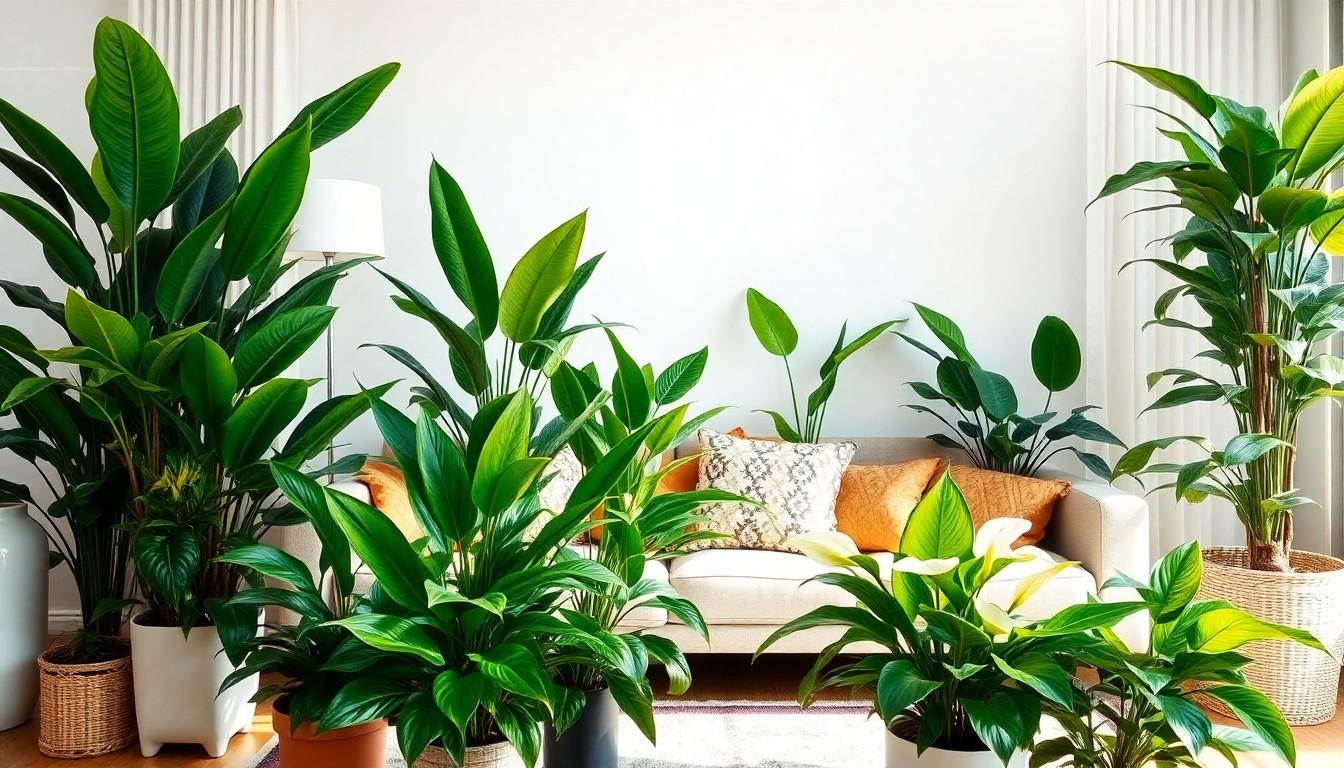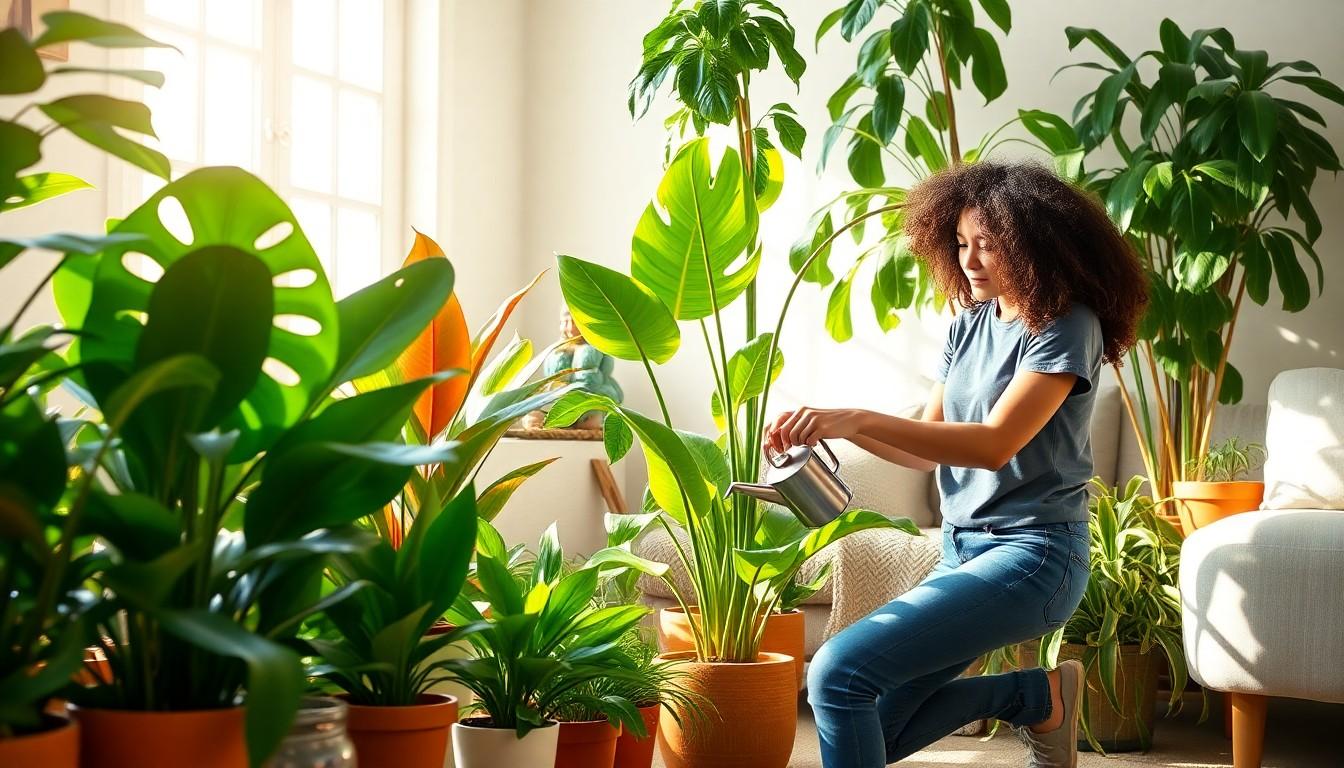Imagine transforming your living space into a lush jungle without ever stepping outside. Indoor tropical house plants offer that perfect escape, turning any room into a vibrant oasis. These green beauties not only look stunning but also purify the air, making your home a healthier place to live. Who knew that a little foliage could do so much?
Overview Of Indoor Tropical House Plants
Indoor tropical house plants create lush environments that elevate the interior of homes. Not only do these plants provide visual interest, but they also contribute positively to indoor air quality. Various species thrive in humidity, which mimics their natural habitats, making them ideal for indoor cultivation.
Common choices include monstera, philodendron, and snake plants. Monstera plants feature distinctive leaves that capture attention, while philodendron varieties offer a range of colors and forms. Snake plants, known for their resilience, require minimal care and tolerate varying light conditions.
Tropical plants also help regulate humidity levels in the home. Increased humidity reduces the proliferation of dust and allergens, benefiting respiratory health. Plants such as peace lilies and bromeliads release moisture into the air, enhancing comfort in dry environments.
Caring for indoor tropical plants generally involves providing adequate light and water. Specific light conditions vary; for instance, some plants prefer bright, indirect sunlight, while others adapt to lower light levels. Regular watering based on individual needs prevents overwatering or underwatering.
Utilizing indoor tropical house plants contributes to a vibrant atmosphere in living spaces. Not only do these plants beautify rooms, but they also foster relaxation and reduce stress levels. Incorporating multiple species together can create a stunning visual impact.
Selecting the right indoor tropical plants can significantly enhance the aesthetic of homes. Consider personal preferences and environmental conditions when choosing species. Embracing these plants leads to a more vibrant and healthier living space.
Benefits Of Indoor Tropical House Plants

Indoor tropical house plants offer numerous advantages, enriching living spaces both visually and environmentally.
Air Quality Improvement
Indoor tropical plants effectively enhance air quality. These plants absorb carbon dioxide and release oxygen, contributing to healthier indoor environments. Additionally, they filter toxins such as formaldehyde and benzene, commonly found in household products. Snake plants and peace lilies serve as excellent air purifiers. Studies indicate that indoor plants can reduce airborne dust and allergens, promoting better respiratory health. By increasing humidity levels, tropical plants help alleviate dry skin and respiratory discomfort. Overall, maintaining a few tropical plants can create a fresher living atmosphere.
Aesthetic Appeal
The visual appeal of indoor tropical plants transforms interiors into vibrant spaces. Lush foliage and unique leaf patterns add depth and character to any room. Monstera and philodendron plants create an inviting atmosphere with their striking appearances. Varied heights and textures contribute to dynamic decor, enhancing any setting. Incorporating these plants into design schemes fosters a natural feel that resonates with tranquility. Choosing tropical plants allows for creative arrangements that reflect personal styles. These elements together elevate the overall aesthetic, making indoor environments more enjoyable and inspiring.
Popular Indoor Tropical House Plants
Indoor tropical house plants come in various types, each bringing unique features and benefits. Here are some popular choices to consider for any living space.
Fiddle Leaf Fig
Fiddle Leaf Fig stands out with its large, glossy leaves that dramatically enhance any room’s ambiance. This plant thrives in bright, indirect light and prefers consistent moisture, making it crucial to avoid overwatering. Ideal for adding height to decor, the fiddle leaf fig can grow up to six feet tall indoors. Its striking appearance makes it a favorite among interior designers. When placing this plant, ensure it has space to grow, allowing its impressive foliage to shine.
Snake Plant
Snake Plant, also known as Sansevieria, is celebrated for its resilience and air-purifying qualities. This hardy plant tolerates low light and infrequent watering, making it an excellent choice for beginners. Its tall, erect leaves add visual interest and texture to rooms. The snake plant helps filter toxins, improving indoor air quality significantly. Homeowners appreciate its ability to thrive on neglect while enhancing the overall aesthetic of any space with minimal effort.
Peace Lily
Peace Lily offers stunning white blooms that contrast beautifully against its dark green leaves. This plant thrives in low to medium light, making it suitable for various indoor environments. Peace Lilies require regular watering to maintain humidity but can tolerate some neglect. They also excel in purifying air, removing harmful toxins effectively. Beyond their air-cleansing properties, these plants create a calming atmosphere, promoting relaxation in living spaces.
Tips For Caring For Indoor Tropical House Plants
Caring for indoor tropical house plants involves understanding their specific needs. Proper light, watering, soil, and fertilization play crucial roles in plant health.
Light Requirements
Light conditions are essential for indoor tropical house plants. Most thrive in bright, indirect sunlight, such as monstera and philodendron. Some, like the snake plant, tolerate low light. Altering light exposure can prevent issues like leaf burn or stunted growth. Position plants near windows but avoid direct sunlight, which can cause damage. Using sheer curtains can diffuse harsh rays effectively. Monitoring light levels regularly ensures plants remain vibrant.
Watering Guidelines
Watering requires careful attention to avoid overwatering or underwatering. Tropical house plants typically prefer consistently moist soil, yet not soggy. Check soil moisture by inserting a finger an inch deep; if it’s dry, water the plant. Each species may have different watering needs, so adapting care to specific plants matters. Providing room temperature water helps reduce shock. Always empty excess water from saucers to prevent root rot. Setting a schedule aids in maintaining proper hydration.
Soil and Fertilization
Choosing the right soil mix enhances root health and growth. Well-draining soil is ideal for tropical plants, helping to prevent waterlogged conditions. A mix of potting soil and perlite or orchid bark promotes excellent drainage. Fertilizing during the growing season stimulates lush growth. Apply a balanced liquid fertilizer every month, but reduce frequency during winter. Monitoring nutrient levels can help maintain healthy foliage and vibrant blooms. Always follow package instructions for optimal results.
Conclusion
Embracing indoor tropical house plants can truly transform a living space into a vibrant oasis. These plants not only enhance the aesthetic appeal but also contribute significantly to a healthier environment. Their air-purifying abilities and humidity regulation create a serene atmosphere that promotes well-being.
Selecting the right tropical plants tailored to individual preferences and home conditions is essential for maximizing their benefits. With proper care and attention, these lush additions can thrive and flourish, providing joy and tranquility. By incorporating indoor tropical house plants, anyone can cultivate a lush retreat that elevates both the beauty and quality of their home.

